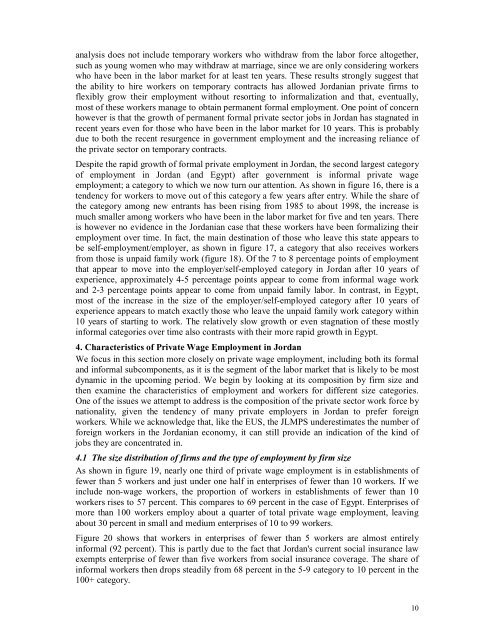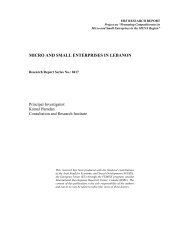The Structure and Evolution of Employment in Jordan - University of ...
The Structure and Evolution of Employment in Jordan - University of ...
The Structure and Evolution of Employment in Jordan - University of ...
You also want an ePaper? Increase the reach of your titles
YUMPU automatically turns print PDFs into web optimized ePapers that Google loves.
analysis does not <strong>in</strong>clude temporary workers who withdraw from the labor force altogether,such as young women who may withdraw at marriage, s<strong>in</strong>ce we are only consider<strong>in</strong>g workerswho have been <strong>in</strong> the labor market for at least ten years. <strong>The</strong>se results strongly suggest thatthe ability to hire workers on temporary contracts has allowed <strong>Jordan</strong>ian private firms t<strong>of</strong>lexibly grow their employment without resort<strong>in</strong>g to <strong>in</strong>formalization <strong>and</strong> that, eventually,most <strong>of</strong> these workers manage to obta<strong>in</strong> permanent formal employment. One po<strong>in</strong>t <strong>of</strong> concernhowever is that the growth <strong>of</strong> permanent formal private sector jobs <strong>in</strong> <strong>Jordan</strong> has stagnated <strong>in</strong>recent years even for those who have been <strong>in</strong> the labor market for 10 years. This is probablydue to both the recent resurgence <strong>in</strong> government employment <strong>and</strong> the <strong>in</strong>creas<strong>in</strong>g reliance <strong>of</strong>the private sector on temporary contracts.Despite the rapid growth <strong>of</strong> formal private employment <strong>in</strong> <strong>Jordan</strong>, the second largest category<strong>of</strong> employment <strong>in</strong> <strong>Jordan</strong> (<strong>and</strong> Egypt) after government is <strong>in</strong>formal private wageemployment; a category to which we now turn our attention. As shown <strong>in</strong> figure 16, there is atendency for workers to move out <strong>of</strong> this category a few years after entry. While the share <strong>of</strong>the category among new entrants has been ris<strong>in</strong>g from 1985 to about 1998, the <strong>in</strong>crease ismuch smaller among workers who have been <strong>in</strong> the labor market for five <strong>and</strong> ten years. <strong>The</strong>reis however no evidence <strong>in</strong> the <strong>Jordan</strong>ian case that these workers have been formaliz<strong>in</strong>g theiremployment over time. In fact, the ma<strong>in</strong> dest<strong>in</strong>ation <strong>of</strong> those who leave this state appears tobe self-employment/employer, as shown <strong>in</strong> figure 17, a category that also receives workersfrom those is unpaid family work (figure 18). Of the 7 to 8 percentage po<strong>in</strong>ts <strong>of</strong> employmentthat appear to move <strong>in</strong>to the employer/self-employed category <strong>in</strong> <strong>Jordan</strong> after 10 years <strong>of</strong>experience, approximately 4-5 percentage po<strong>in</strong>ts appear to come from <strong>in</strong>formal wage work<strong>and</strong> 2-3 percentage po<strong>in</strong>ts appear to come from unpaid family labor. In contrast, <strong>in</strong> Egypt,most <strong>of</strong> the <strong>in</strong>crease <strong>in</strong> the size <strong>of</strong> the employer/self-employed category after 10 years <strong>of</strong>experience appears to match exactly those who leave the unpaid family work category with<strong>in</strong>10 years <strong>of</strong> start<strong>in</strong>g to work. <strong>The</strong> relatively slow growth or even stagnation <strong>of</strong> these mostly<strong>in</strong>formal categories over time also contrasts with their more rapid growth <strong>in</strong> Egypt.4. Characteristics <strong>of</strong> Private Wage <strong>Employment</strong> <strong>in</strong> <strong>Jordan</strong>We focus <strong>in</strong> this section more closely on private wage employment, <strong>in</strong>clud<strong>in</strong>g both its formal<strong>and</strong> <strong>in</strong>formal subcomponents, as it is the segment <strong>of</strong> the labor market that is likely to be mostdynamic <strong>in</strong> the upcom<strong>in</strong>g period. We beg<strong>in</strong> by look<strong>in</strong>g at its composition by firm size <strong>and</strong>then exam<strong>in</strong>e the characteristics <strong>of</strong> employment <strong>and</strong> workers for different size categories.One <strong>of</strong> the issues we attempt to address is the composition <strong>of</strong> the private sector work force bynationality, given the tendency <strong>of</strong> many private employers <strong>in</strong> <strong>Jordan</strong> to prefer foreignworkers. While we acknowledge that, like the EUS, the JLMPS underestimates the number <strong>of</strong>foreign workers <strong>in</strong> the <strong>Jordan</strong>ian economy, it can still provide an <strong>in</strong>dication <strong>of</strong> the k<strong>in</strong>d <strong>of</strong>jobs they are concentrated <strong>in</strong>.4.1 <strong>The</strong> size distribution <strong>of</strong> firms <strong>and</strong> the type <strong>of</strong> employment by firm sizeAs shown <strong>in</strong> figure 19, nearly one third <strong>of</strong> private wage employment is <strong>in</strong> establishments <strong>of</strong>fewer than 5 workers <strong>and</strong> just under one half <strong>in</strong> enterprises <strong>of</strong> fewer than 10 workers. If we<strong>in</strong>clude non-wage workers, the proportion <strong>of</strong> workers <strong>in</strong> establishments <strong>of</strong> fewer than 10workers rises to 57 percent. This compares to 69 percent <strong>in</strong> the case <strong>of</strong> Egypt. Enterprises <strong>of</strong>more than 100 workers employ about a quarter <strong>of</strong> total private wage employment, leav<strong>in</strong>gabout 30 percent <strong>in</strong> small <strong>and</strong> medium enterprises <strong>of</strong> 10 to 99 workers.Figure 20 shows that workers <strong>in</strong> enterprises <strong>of</strong> fewer than 5 workers are almost entirely<strong>in</strong>formal (92 percent). This is partly due to the fact that <strong>Jordan</strong>'s current social <strong>in</strong>surance lawexempts enterprise <strong>of</strong> fewer than five workers from social <strong>in</strong>surance coverage. <strong>The</strong> share <strong>of</strong><strong>in</strong>formal workers then drops steadily from 68 percent <strong>in</strong> the 5-9 category to 10 percent <strong>in</strong> the100+ category.10

















